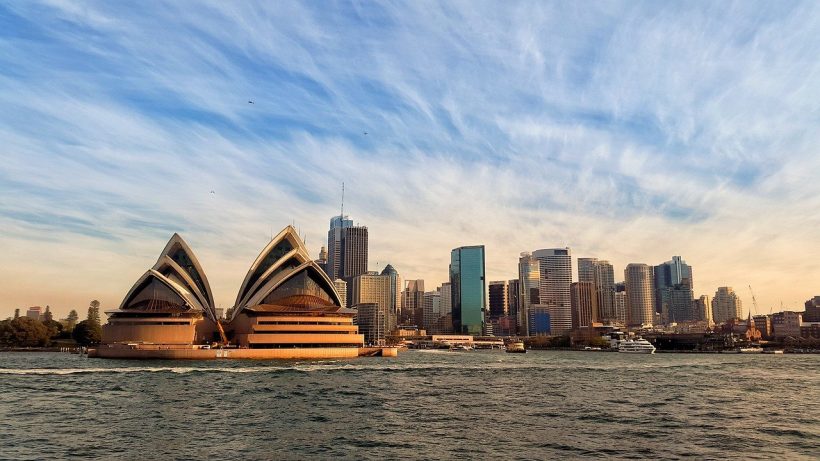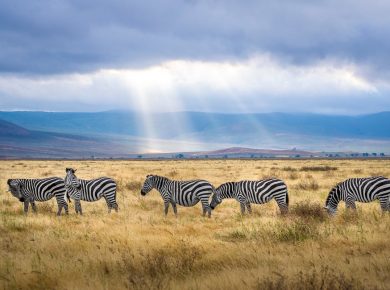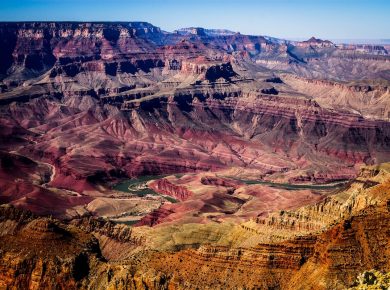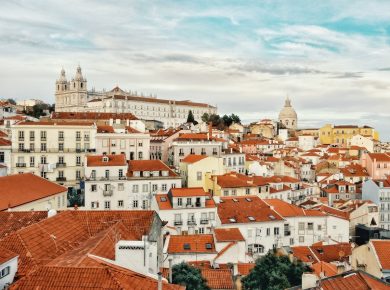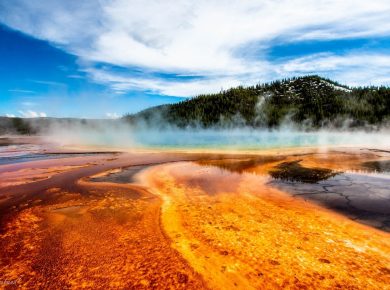It’s some time into March. This winter has been a harsh and long one and you’ve been having dreams about visiting Sydney, Australia and soaking up that warm Australian sun. Well, you’re in luck: March is actually the best time to get great weather in Australia, having both good weather and being among the cheapest months for travel!
Sydney, also known as “Harbor City” for its large Port Jackson Bay, is located in the south-eastern portion of the Australian continent. As is the case with all places in that half of the world, the seasons are flipped – June represents the middle of winter while December represents the middle of the summer.
This is great news if you’re looking to escape the cold. Sydney is one of the most populated cities in Australia, just narrowly beating Melbourne which means it has both nice weather and plenty of things to do.
March is the best time to visit Australia, having both good weather and being among the cheapest months for travel!
Sydney technically has a humid subtropical climate which can make it quite muggy during its summer months however the shoulder seasons are less humid and experience a little less rainfall than the other seasons. The peak season is considered to be December through February with the off season being June through August.
Unlike many other destinations, the peaks and lows for traveling aren’t necessarily the same as for accommodation. Given its size and generally moderate weather, you’ll always have something to do no matter when you visit.
Table of Contents
Average Temperature In Sydney
Though the climate is described as being humid and subtropical there is still a fair amount of temperature variance between the different seasons. As is the case in all coastal cities, extreme temperatures at the height of warm and cold seasons are moderated by the adjacent Tasman Sea.
The warm season begins at the end of November and finishes at the tail end of March, while the cool season starts in June and lasts a much shorter time, ending around the middle of August.
Compared to Australia as a whole Sydney is quite temperate, with the peak warm season seeing average highs of 80 degrees Fahrenheit during the day and average lows of 68 degrees Fahrenheit at night during January.
The peak cold season occurs in July with average highs of 62 degrees Fahrenheit and average lows of 47 degrees Fahrenheit. The warm season weather rarely rises above 90 degrees Fahrenheit, while the cold season rarely drops below 40 degrees Fahrenheit.
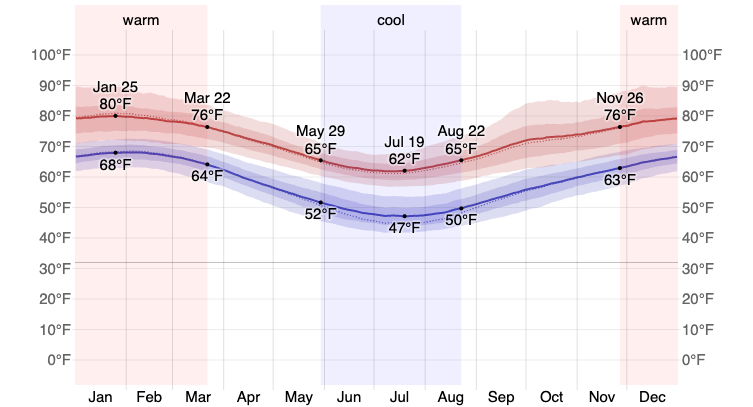
Daily Chance Of Precipitation In Sydney
The daily chance of precipitation in Sydney is surprisingly uniform, though it does have distinct wet and dry seasons. The wet season begins in the middle of October and ends at the very start of June.
The wettest time of the year occurs in the transition between January and February, when the average daily precipitation chance averages 30%. The dry season begins at the start of June with the driest month being August with an average daily precipitation chance of 16%.
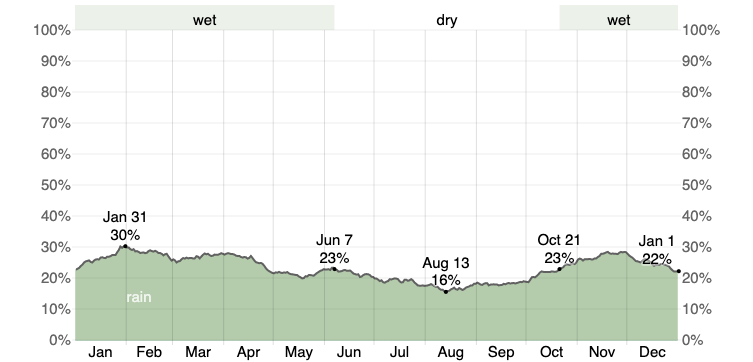
Because of how the rain is distributed, the wet season happens to correspond largely with the warm season which means that the busiest months are also among the wettest months. Due to how long the wet season is however, the shoulder months are also wet. It’s hard to avoid rain in Sydney, unless you travel in the middle of the cold season.
Humidity Comfort Levels In Sydney
Due to the nature of it’s subtropical climate, Sydney has a very distinct humid season which gets particularly muggy around the start of December and lasts through to March. The peak of this humid season occurs on average in the middle of February before declining and finally ending in March.
Despite the peak in February, both January and February tend to have the same rate of muggy days, with an average of 10.6 days that are considered muggy. The difference lies in the rate of days that become oppressively humid, which February has a higher rate than January.
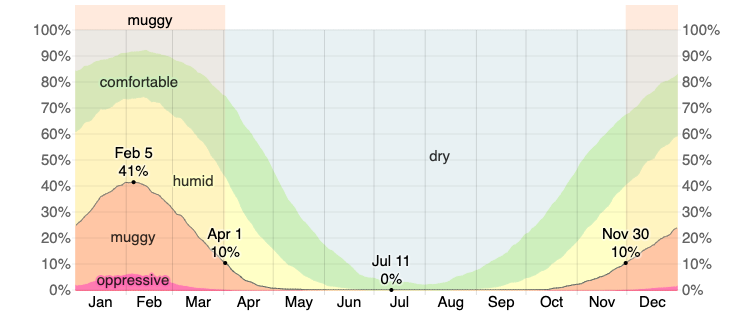
March also tends to have more muggy days than December, with both having 6.3 and 5.5 muggy days respectively. By April, the amount of days considered muggy drops down drastically to an average of 1.2 days, and from May through September, the humidity levels tend to be largely dry or comfortable.
Best Time Of Year To Visit Sydney For Great Weather
Because the summer time in Sydney is also its wettest and most humid time, if you’re looking to visit Sydney with enjoyable weather your best bet to balance warm weather with low humidity is to go during or near the shoulder seasons, particularly during the end of March or any time in November.
The weather will still be warm with the average weather being in the mid 70s during both months. March is generally warmer than November, but has more rain and a higher rate of muggy days.
Ultimately, the best weather in Sydney depends on which kind of weather you want. When it comes to totally avoiding humidity you’ll want to visit any time from April to November. The span of time between the end of July and the beginning of August represents the driest period of the year on average.
If temperature is your biggest concern, then the warmest months are December and January. While the warm months tend to have rainier days, average rainfall is fairly static both in amount and rainy days across the entire year. With that said, February tends to have the most rainy days and July the least.
Best Time Of Year To Visit Sydney For Low Prices
When considering prices for Sydney (or really anywhere in Australia), it’s important to distinguish between travel costs and accommodation costs. You might expect these things to correlate but because of Australia’s isolation and the relatively small number of cities (all of which are among the most expensive places to live in the world), these two costs tend to fluctuate at different times.
You’ll often find travel costs to be quite high year round, with round trip travel costs often exceeding the total cost of weekly accommodations! What this means is that you have to really consider the length of time of your visit as a major factor when trying to reduce cost.
When it comes to flights there are three separate months that have low prices on average: March, May, and November. You can expect a round trip price of about $1700 during November, generally considered to be the cheapest month and part of the second shoulder season.
In contrast, the highest months are January, July, and December, and a round trip price during these months will range from $2000 to $2400. The price of accommodations tends to be higher when the airline prices are cheaper.
The cheapest time to find a room is any time between March and July, where you can expect to pay about $120 per night for a three-star hotel. Prices start to rise by September and spike during December.
In December, prices can exceed $200 per night. Since the price of travel will generally dwarf the price of accommodations, you can save money using a service such as AirBnB, which is almost always cheaper than staying at a hotel. It isn’t unusual to get an AirBnB room for half the price of a hotel room.
When Should You Go To Sydney?
Peak Travel Season In Sydney
The peak travel season for Sydney starts in December and ends in February. These months are the summer months for Sydney and correspond with the winter in the northern hemisphere. Besides being the hottest months of the year they are also the wettest, with the January-February time particularly having more rainy days.
February is the wettest month on average with an average rainfall of four inches, but it isn’t impossible to have over eight inches in certain years. Similarly to pacific coast locales, the wetness of the region is influenced by oscillating climate patterns which will make some years much drier than others. It is also worth noting that while having the most rain, it is also by far the most humid time of year, especially during late January or early February.
As far as prices are concerned you’ll find accommodations being among the most expensive of the whole year during the peak season, especially in December, where hotel prices can rise up to almost $240 per night.
January is the cheapest month with regards to the cost of accommodations during the peak season, but prices can still be upwards of about $150 per night. It is possible to save money using a service like AirBnB, which can be much cheaper than your typical hotel.
Airline prices are another story altogether: while ticket prices also peak in December to about $1200 one way, they drop substantially during February to an average price of $800 one way.
There are a lot of variables to consider when trying to travel during peak season. If you want the weather to be more tame and less muggy, then your best bet is to travel during the end of December or early January. If you’re planning an extended vacation and are trying to cut down on costs then your best bet would be to come during early January and leave at the start of February.
Shoulder Travel Season In Sydney
The first shoulder season begins in March and goes through to the middle of May. During this time of year you begin to see the temperature drop about ten degrees, particularly by April, although you still tend to find rain throughout these months.
The humidity also starts to drop in March, and by May the weather becomes generally comfortable. The second shoulder season begins at the very end of August and lasts until December.
The weather is very similar to the first shoulder season with temperature averages being more stable but largely similar in terms of highs and lows. It is far less humid, with the humidity at the end of the second shoulder season being comparable to the humidity at the start of the first shoulder season.
For pricing, you’ll find that the first shoulder season is generally less expensive overall, although the months matter. Both March and May are among the least expensive in terms of ticket pricing while April sees a fairly high spike in those prices.
Once out of the high season, accommodation prices tend to stay relatively static but lowers slightly as the season carries on. During the second shoulder season, ticket prices drop substantially after the low season prices, although the average prices are still higher than you find in the first shoulder season.
The one exception is November, right before the initial high season peak, which is the lowest average ticket price you find. Accommodation is generally more expensive in the second shoulder season although it’s only a difference of about $15 to $20, up until November when the prices really start to rise and reach that December peak.
Similarly to the peak season, the best time to go during shoulder seasons largely depends on what it is you’re looking for. You’ll find the second shoulder season is generally more expensive than the first though the cost differences aren’t very dramatic.
If you’re trying to get the cheapest trip then your best bet would be to travel during the end of the first shoulder season. If you’re looking for the best weather, then the second shoulder season is the time to go.
Low Travel Season In Sydney
The off season starts in June and ends in August. Don’t let the name fool you – the off season is one of the most expensive times of the year. Not only are the ticket prices high, but accommodation prices stay their same price from the shoulder season.
The weather, while cooler, is still fairly comfortable with average highs in the low 60s and average lows in the high 40s. The humidity is also the lowest it gets during the whole year, with this season being quite dry.
While you should still expect regular rain throughout this season, it rains less and lighter during this time of year. The weather being fairly static, you can expect largely the same weather throughout the off season. The coldest period is July, while the clearest period is in August.
Regarding prices, the least expensive tickets are found in June, but spike up to $1100 a ticket by July, meaning really no matter which part of the off season you travel, you’ll be paying a pretty hefty price.
Best Months For Travel To Sydney
While March is a good bet to have good weather and fairly low prices, it’s hard to name a definitively best time to visit Sydney. The regional climate is variable, and due to the remoteness of Australia in general, the cost of travel and accommodations doesn’t always line up with the traditional ideas of high and low seasons.
While this can seem confusing and make planning complicated, the flip-side is that this gives you lots of options to strategist pricing with preferred weather. Whether you want more humid or more dry, more warm or more cold, it’s possible to visit during your preferred climate without emptying your wallet.
